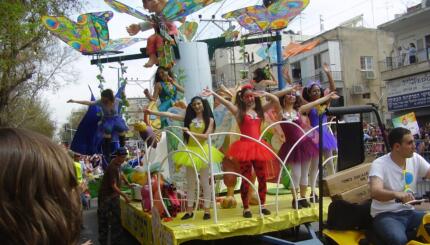Imagine by the crystal clear and warm waters of the Caribbean Sea. No need for warm costumes or shoveling out the entrance to the synagogue. This week not one but two Jewish communities will have the opportunity to do just that, in a modern and multicultural celebration of an ancient Jewish holiday.
The blue sea is the only backdrop the Jews of Santa Marta Colombia have ever known to Purim and other Jewish holidays. They are an emerging community made up exclusively of Caribbean converts who, in the past decade, have built a small but strong chavurah, prayer community. Generally they are on their own when it comes to Jewish life. But this week, students from Vanderbilt University Hillel are joining them.
The 10 day alternative spring break for the visit, organized in conjunction with Be’chol Lashon is introducing these American Jews to the richness and diversity of Jewish life in Colombia. They started in the heights Bogata, where they met the established historic Jewish community before setting off for the shores of Caribbean.
In coming to Santa Marta, these young American Jews will be exposed to a community which, like a time machine, mirrors the origins of their own communities in North America many decades or centuries ago (picture the first Jews of New Amsterdam, or the first Jews to wander into the Tennessee frontier). There is a one-room synagogue with one little and a small Hebrew Sunday School. There is no fancy buildings, no rabbi in site, but bucketfuls of enthusiasm to make Jewish life thrive and grow in a place where it had not before.
At the same time, the Colombian Jews will be confronted with the image of complex hyphenated Jewish American youths coming from a place where Judaism feeds the surrounding culture and is in turn nourished and morphed by it: almost a utopian dream for such a small minority culture, still in its institutional and demographic infancy.
However, as it has happened in the past with other visiting Jews, the common threads of our story will bind us together. The American students will not be eating hamentaschen this year, but rather, they will feast on a very different gastronomy. The music coming out of the speakers (louder than most American are accustomed to) during the Purim celebration will be ripe with foreign cadences. And yet, it will still be Purim. Unequivocally Purim. With Esther and Mordechai and gifts for the poor, and mishloach manot. Haman will be cursed not only in one but in many languages. Despite their differences, in the illustrious tradition of Jewish travelers throughout time, both groups will find common ground.
And it is particularly fitting that this encounter of two cultures is happening on Purim, the first truly global holiday. A people dispersed throughout the 127 provinces of the vast reaching Persian Empire, from India to Ethiopia (meHodu vead Kush) found joint reasons for revelry, and, in doing so, started to take responsibility for one another across the broad expanses of Diaspora, language, and culture. The encounter between Vanderbilt Hillel’s alternative spring break and the local Jewish community of Santa Marta will honor and renew the commitment “assumed and received” by the Jewish people on that first Purim of finding common ground in the face of adversity, but also, not less profoundly, in the promise of shared joy.



